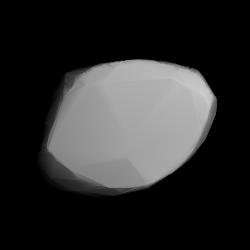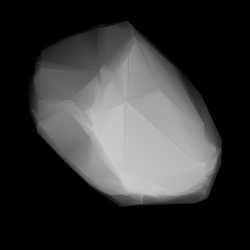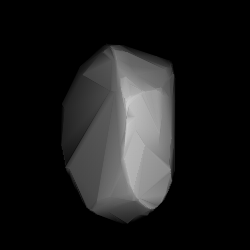Related Research Articles

1743 Schmidt, provisional designation 4109 P-L, is a dark background asteroid from the inner regions of the asteroid belt, approximately 19 kilometers in diameter. It was discovered during the Palomar–Leiden survey on 24 September 1960, by astronomers Ingrid and Cornelis van Houten at Leiden, on photographic plates taken by Tom Gehrels at Palomar Observatory in California. The C-type asteroid has a rotation period of 17.5 hours. It was named for the optician Bernhard Schmidt.
Pawlowia, provisional designation 1923 OX, is a background asteroid from the central regions of the asteroid belt, approximately 20 kilometers in diameter. It was discovered on 5 October 1923, by Soviet astronomer Vladimir Albitsky at the Simeiz Observatory on the Crimean peninsula. The asteroid was named after Russian physiologist and Nobelist Ivan Pavlov.
1179 Mally, provisional designation 1931 FD, is an asteroid and long-lost minor planet from the central region of the asteroid belt, approximately 13 kilometers in diameter. Discovered by Max Wolf in 1931, the asteroid was lost until its rediscovery in 1986. The discoverer named it after his daughter-in-law, Mally Wolf.
1049 Gotho, provisional designation 1925 RB, is a carbonaceous asteroid from the outer region of the asteroid belt, approximately 53 kilometers in diameter. It was discovered on 14 September 1925, by German astronomer Karl Reinmuth at Heidelberg Observatory in southwest Germany. Although the name of the asteroid is a masculine German name, it is not known to refer to a particular individual.
1092 Lilium, provisional designation 1924 PN, is a dark, carbonaceous background asteroid from the outer regions of the asteroid belt, approximately 44 kilometers in diameter. It was discovered on 12 January 1924, by German astronomer Karl Reinmuth at the Heidelberg Observatory in southwest Germany. The asteroid was named after the flower Lilium.

1118 Hanskya is a large background asteroid, approximately 77 kilometers in diameter, located in the outer regions of the asteroid belt. Discovered by Sergey Belyavsky and Nikolaj Ivanov in 1927, it was named after Russian astronomer Aleksey Hansky. The presumed dark C-type asteroid has a rotation period of 15.6 hours.
1123 Shapleya, provisional designation 1928 ST, is a stony Florian asteroid from the inner regions of the asteroid belt, approximately 11 kilometers in diameter. It was discovered on 21 September 1928, by Russian astronomer Grigory Neujmin at Simeiz Observatory on the Crimean peninsula. It was named after American astronomer Harlow Shapley.
1567 Alikoski, provisional designation 1941 HN, is a rare-type carbonaceous asteroid from the outer region of the asteroid belt, approximately 67 kilometers in diameter. It was discovered on 22 April 1941, by Finnish astronomer Yrjö Väisälä at Turku Observatory in Southwest Finland. It was later named after Finnish astronomer Heikki Alikoski.
1815 Beethoven, provisional designation 1932 CE1, is a carbonaceous background asteroid from the outer regions of the asteroid belt, approximately 30 kilometers (19 miles) in diameter. It was discovered on 27 January 1932, by German astronomer Karl Reinmuth at the Heidelberg Observatory. The uncommon F-type asteroid seems to have a long rotation period of 54 hours (tentative). It was named after Ludwig van Beethoven.
1250 Galanthus, provisional designation 1933 BD, is a dark background asteroid from the central regions of the asteroid belt, approximately 20 kilometers in diameter. It was discovered on 25 January 1933, by German astronomer Karl Reinmuth at the Heidelberg Observatory. The asteroid was named for the herbaceous plant Galanthus, also known as "snowdrop".
1524 Joensuu, provisional designation 1939 SB, is a carbonaceous asteroid from the outer region of the asteroid belt, approximately 42 kilometers in diameter. It was discovered on 18 September 1939, by Finnish astronomer Yrjö Väisälä at Turku Observatory in Southwest Finland, and named for the town of Joensuu.
1303 Luthera, provisional designation 1928 FP, is a dark asteroid and the parent body of the Luthera family, located in the outermost regions of the asteroid belt. It measures approximately 90 kilometers in diameter. The asteroid was discovered on 16 March 1928, by astronomer Friedrich Schwassmann at the Bergedorf Observatory in Hamburg, Germany, and later named after German astronomer Robert Luther.
3066 McFadden, provisional designation 1984 EO, is a stony background asteroid from the central regions of the asteroid belt, approximately 15 kilometers in diameter. It was discovered on 1 March 1984, by American astronomer Edward Bowell at the Anderson Mesa Station near Tucson, Arizona. It was named for American planetary scientist Lucy-Ann McFadden. The assumed S-type asteroid has a rotation period of 13.8 hours.
2043 Ortutay, provisional designation 1936 TH, is a dark asteroid from the outer regions of the asteroid belt, approximately 45 kilometers in diameter. The asteroid was discovered by Hungarian astronomer György Kulin at the Konkoly Observatory, Budapest, on 12 November 1936. It was named after Hungarian ethnographer Gyula Ortutay.
2122 Pyatiletka, provisional designation 1971 XB, is a stony asteroid from the inner regions of the asteroid belt, approximately 11 kilometers in diameter.
1760 Sandra, provisional designation 1950 GB, is a carbonaceous asteroid from the outer regions of the asteroid belt, approximately 35 kilometers in diameter. It was discovered on 10 April 1950, by South African astronomer Ernest Johnson at Union Observatory in Johannesburg, and named after his granddaughter Sandra.

2111 Tselina is a stony Eos asteroid from the outer regions of the asteroid belt. It was discovered on 13 June 1969, by Soviet astronomer Tamara Smirnova at Crimean Astrophysical Observatory in Nauchnij, on the Crimean peninsula. The S-type asteroid has a rotation period of 6.6 hours and measures approximately 23 kilometers in diameter. It was later named after the Soviet Virgin Lands Campaign.
1323 Tugela, provisional designation 1934 LD, is a dark background asteroid from the outer regions of the asteroid belt, approximately 60 kilometers in diameter. It was discovered on 19 May 1934, by South African astronomer Cyril Jackson at the Union Observatory in Johannesburg. The asteroid was named for the Tugela River in western South Africa.
1302 Werra, provisional designation 1924 SV, is a Themistian asteroid from the outer regions of the asteroid belt, approximately 30 kilometers in diameter. It was discovered on 28 September 1924, by German astronomer Karl Reinmuth at the Heidelberg-Königstuhl State Observatory. The asteroid was named for the river Werra in central Germany.
1461 Jean-Jacques, provisional designation 1937 YL, is a metallic asteroid from the outer region of the asteroid belt, approximately 34 kilometers in diameter. It was discovered on 30 December 1937, by French astronomer Marguerite Laugier at Nice Observatory in southern France, who named it after her son Jean-Jacques Laugier.
References
- 1 2 3 4 5 6 "JPL Small-Body Database Browser: 3578 Carestia (1977 CC)" (2017-05-02 last obs.). Jet Propulsion Laboratory . Retrieved 19 June 2017.
- 1 2 3 Schmadel, Lutz D. (2007). "(3578) Carestia". Dictionary of Minor Planet Names – (3578) Carestia. Springer Berlin Heidelberg. p. 301. doi:10.1007/978-3-540-29925-7_3577. ISBN 978-3-540-00238-3.
- 1 2 3 Masiero, Joseph R.; Grav, T.; Mainzer, A. K.; Nugent, C. R.; Bauer, J. M.; Stevenson, R.; et al. (August 2014). "Main-belt Asteroids with WISE/NEOWISE: Near-infrared Albedos". The Astrophysical Journal. 791 (2): 11. arXiv: 1406.6645 . Bibcode:2014ApJ...791..121M. doi:10.1088/0004-637X/791/2/121 . Retrieved 5 December 2016.
- 1 2 3 4 Mainzer, A.; Grav, T.; Masiero, J.; Hand, E.; Bauer, J.; Tholen, D.; et al. (November 2011). "NEOWISE Studies of Spectrophotometrically Classified Asteroids: Preliminary Results". The Astrophysical Journal. 741 (2): 25. arXiv: 1109.6407 . Bibcode:2011ApJ...741...90M. doi:10.1088/0004-637X/741/2/90 . Retrieved 25 May 2016.
- 1 2 3 4 Tedesco, E. F.; Noah, P. V.; Noah, M.; Price, S. D. (October 2004). "IRAS Minor Planet Survey V6.0". NASA Planetary Data System. 12: IRAS-A-FPA-3-RDR-IMPS-V6.0. Bibcode:2004PDSS...12.....T . Retrieved 22 October 2019.
- 1 2 3 4 Usui, Fumihiko; Kuroda, Daisuke; Müller, Thomas G.; Hasegawa, Sunao; Ishiguro, Masateru; Ootsubo, Takafumi; et al. (October 2011). "Asteroid Catalog Using Akari: AKARI/IRC Mid-Infrared Asteroid Survey". Publications of the Astronomical Society of Japan. 63 (5): 1117–1138. Bibcode:2011PASJ...63.1117U. doi:10.1093/pasj/63.5.1117. (online, AcuA catalog p. 153)
- 1 2 3 4 5 6 "LCDB Data for (3578) Carestia". Asteroid Lightcurve Database (LCDB). Retrieved 25 May 2016.
- 1 2 3 4 Masiero, Joseph R.; Mainzer, A. K.; Grav, T.; Bauer, J. M.; Cutri, R. M.; Nugent, C.; et al. (November 2012). "Preliminary Analysis of WISE/NEOWISE 3-Band Cryogenic and Post-cryogenic Observations of Main Belt Asteroids". The Astrophysical Journal Letters. 759 (1): 5. arXiv: 1209.5794 . Bibcode:2012ApJ...759L...8M. doi:10.1088/2041-8205/759/1/L8 . Retrieved 25 May 2016.
- 1 2 3 Holliday, B. (March 1997). "Photometric Observations of Minor Planet 3578 Caresia". The Minor Planet Bulletin. 24.: 1. Bibcode:1997MPBu...24....1H . Retrieved 25 May 2016.
- 1 2 Behrend, Raoul. "Asteroids and comets rotation curves – (3578) Carestia". Geneva Observatory . Retrieved 25 May 2016.
- ↑ Veres, Peter; Jedicke, Robert; Fitzsimmons, Alan; Denneau, Larry; Granvik, Mikael; Bolin, Bryce; et al. (November 2015). "Absolute magnitudes and slope parameters for 250,000 asteroids observed by Pan-STARRS PS1 - Preliminary results". Icarus. 261: 34–47. arXiv: 1506.00762 . Bibcode:2015Icar..261...34V. doi:10.1016/j.icarus.2015.08.007 . Retrieved 25 May 2016.
- 1 2 "3578 Carestia (1977 CC)". Minor Planet Center. Retrieved 25 May 2016.
- ↑ "MPC/MPO/MPS Archive". Minor Planet Center. Retrieved 25 May 2016.